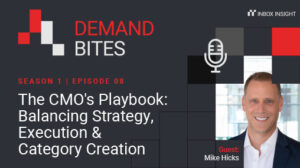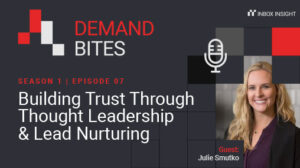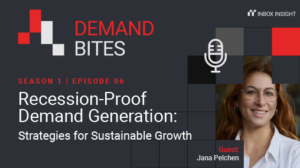Demand Generation Managers face a relentless balancing act. Budgets are tight, resources are limited, and every strategy must prove its worth with tangible ROI. Traditional lead generation tactics can often feel outdated—intrusive cold calls, endless email chains, and static ads that fail to inspire engagement.
Meanwhile, the pressure to consistently deliver high-quality leads grows louder. You need a scalable approach that not only fills your pipeline but also builds trust and credibility with your audience. The old ways aren’t just inefficient; they’re actively hindering your ability to stand out in today’s content-driven marketplace.
Enter content marketing — by creating and sharing valuable, audience-centric content, you attract, engage, and convert leads naturally. It’s not about interrupting; it’s about solving problems, building relationships, and positioning your brand as a trusted partner. With the right strategies, content marketing can transform your lead generation process into a sustainable engine for growth and measurable success.
Why is content marketing so essential for lead generation?
Content marketing is not just a trend; it’s a fundamental component of modern marketing strategies. With over 73% of B2B marketers using it as part of their overall marketing strategy, it’s clear that businesses are seeing the value it can bring.
One of the biggest benefits of content marketing lies in its cost-effectiveness. Leads generated through content marketing cost 62% less than traditional marketing leads, making it an attractive option for companies looking to optimize their budgets.
But it’s not just about saving money. Businesses that use content marketing also experience six times higher conversion rates compared to those that do not, proving its power to drive meaningful engagement and deliver real impact.
How to build a lead-generating content strategy
For Demand Generation Managers working with limited resources, creating a lead-generating content strategy can seem daunting. However, a clear and structured approach can simplify the process and deliver impressive results.
1. Define lead generation goals
Start by establishing clear, SMART (Specific, Measurable, Achievable, Relevant, Time-bound) objectives. Whether your focus is on boosting the number of qualified leads or improving conversion rates, having well-defined goals provides direction and a way to measure your success.
2. Identify your target audience
Utilize internal customer data to pinpoint your target audience’s pain points and preferences. By understanding what matters most to them, you can create content that directly addresses their needs and interests, helping to build stronger, more meaningful connections.
3. Elevate keyword research with data-driven tools
Keyword research is the foundation of effective content strategies. With the right tools, marketers can unlock valuable insights that fuel success:
- Google Trends highlights seasonal patterns and emerging trends
- Ahrefs uncovers competitor strategies and high-impact keywords
- Google Ads Keyword Planner helps identify long-tail keywords for niche targeting
- Bombora intent data reveals trending topics and audience interests
Using these tools together, you can gain a comprehensive understanding of your audience’s needs, track emerging trends, and monitor your competitors. This approach enables more effective targeting of high-intent users while ensuring your content remains relevant, engaging, and impactful in driving visibility and conversions.
4. Align content with search intent
Your content should speak directly to the challenges decision-makers face. By aligning your content with their search intent, you ensure that it resonates with their pain points and offers meaningful solutions, thereby increasing the likelihood of conversion.
5. Create high-quality, valuable content
Collaborate with subject matter experts to produce content that is both informative and engaging. High-quality content like this not only establishes you as a trusted authority in your industry, but also builds trust with your audience.
The impact of this is clear: 75% of decision-makers trust a brand more if it’s associated with industry experts or influencers. This goes to show just how powerful it can be to involve subject matter experts in your content creation.
6. Optimize for conversions
You need to ensure that your content is optimized for conversions by incorporating trackable calls-to-action (CTAs) and dedicated landing pages. This creates a smooth path from content consumption to lead capture, maximizing the effectiveness of your strategy.
7. Choose the right distribution strategies
Efficient distribution is key to maximizing content reach and driving lead generation. Currently, only 42% of B2B marketers consider their content distribution efforts to be effective. To maximize your results, focus on integrating the following key strategies into your approach:
- Email automation: Personalize and segment campaigns to deliver relevant content at each stage of the buyer’s journey
- Paid ads: Utilize targeted ads on dominant platforms like Google and LinkedIn to capture high-intent leads and retarget audiences effectively
- Influencer marketing: Partner with industry experts to promote gated content, webinars, or case studies. Doing so can not only yield three times as many leads as traditional methods, but also has an average conversion rate of 13%
- Content Syndication: Utilize cost-effective methods like content syndication to enhance your reach and deliver superior ROI. Strategic promotion ensures your content is available to a wider audience, creating more qualified lead generation opportunities
By integrating these strategies, you create a cohesive distribution system that amplifies content visibility, enhances credibility, and drives measurable results.
8. Update and repurpose your content
To maximize the lifespan of your content, regularly update and repurpose it using a structured content repurposing workflow. This approach not only saves resources but also ensures your material remains relevant and continues to generate leads over time.
Content is king, but which types reign supreme?
When it comes to choosing what content types you should use for lead generation, it’s important to balance what works best with the resources you have. 42% of B2B buyers consult 4-6 different sources when researching a purchase, so it’s best to maintain a good variety. Here are some of the most effective options:
- Blog posts: Optimized blog posts can attract organic traffic and keep readers engaged. Repurposing long-form content into blog posts is a great way to extend their reach and utility
- eBooks and whitepapers: These types of resources provide valuable insights to your readers, and can be used as lead magnets to capture contact information
- Webinars: Webinars are effective for engaging leads at various funnel stages. They offer interactive opportunities to showcase expertise and address specific audience questions
- Case studies: These are a great way to leverage real data, insights, and customer success stories that demonstrate the effectiveness of your solutions and build trust in your brand
- Videos and podcasts: Evergreen and cost-effective, videos and podcasts cater to different audience preferences and can be easily distributed across multiple channels
Measuring the success of your content marketing lead generation
Tracking the success of your content marketing strategy is essential—not just for improving your results, but also for proving your ROI.
To do this effectively, you will need to keep an eye on key performance indicators (KPIs) like pipeline influence, marketing qualified leads (MQLs), and sales qualified leads (SQLs). These metrics will give you a clear picture of how well your content is driving leads through the content marketing funnel.
You can also use accessible tools and metrics to regularly analyze your content’s performance to refine your strategy and keep improving results. Platforms like Google Analytics, will allow you to track page visits on your content as part of wider customer journeys. Adding custom events like scroll depth, time on page, and clicking Calls to Action will help you see which content is most engaging. When they complete a form and log in, your marketing automation platform can give more information on these journeys.
Work closely with your external partners to match content analytics and buyer intent signals happening off of your site to what you see in your view. This will give you a better picture of what is happening and help trigger sales conversations at the right time.
Revolutionize your lead generation with effective content marketing
Content marketing is a game-changer for lead generation. By setting clear goals, understanding your audience, diving into thorough keyword research, and picking the right content formats and distribution channels, you can build a strategy that’s both sustainable and effective.
Start small—implement these steps on a manageable scale, then expand as you learn what works best. Remember, delivering consistent and valuable content isn’t just part of the process; it’s the foundation of a successful lead generation strategy.
Are you ready to fuel your lead generation strategy with content that engages and coverts? Explore Inbox Insight’s range of content creation services and discover how we can do the heavy lifting for you.






